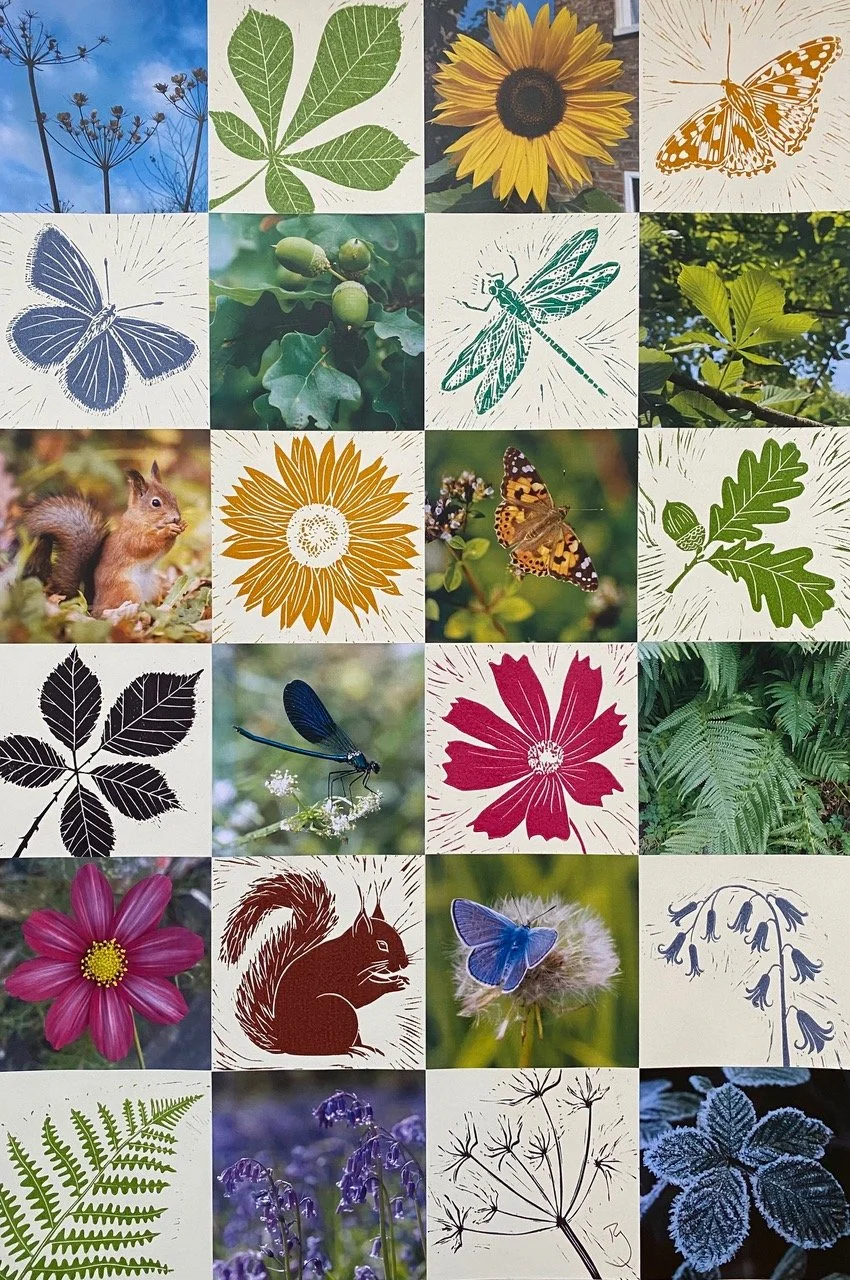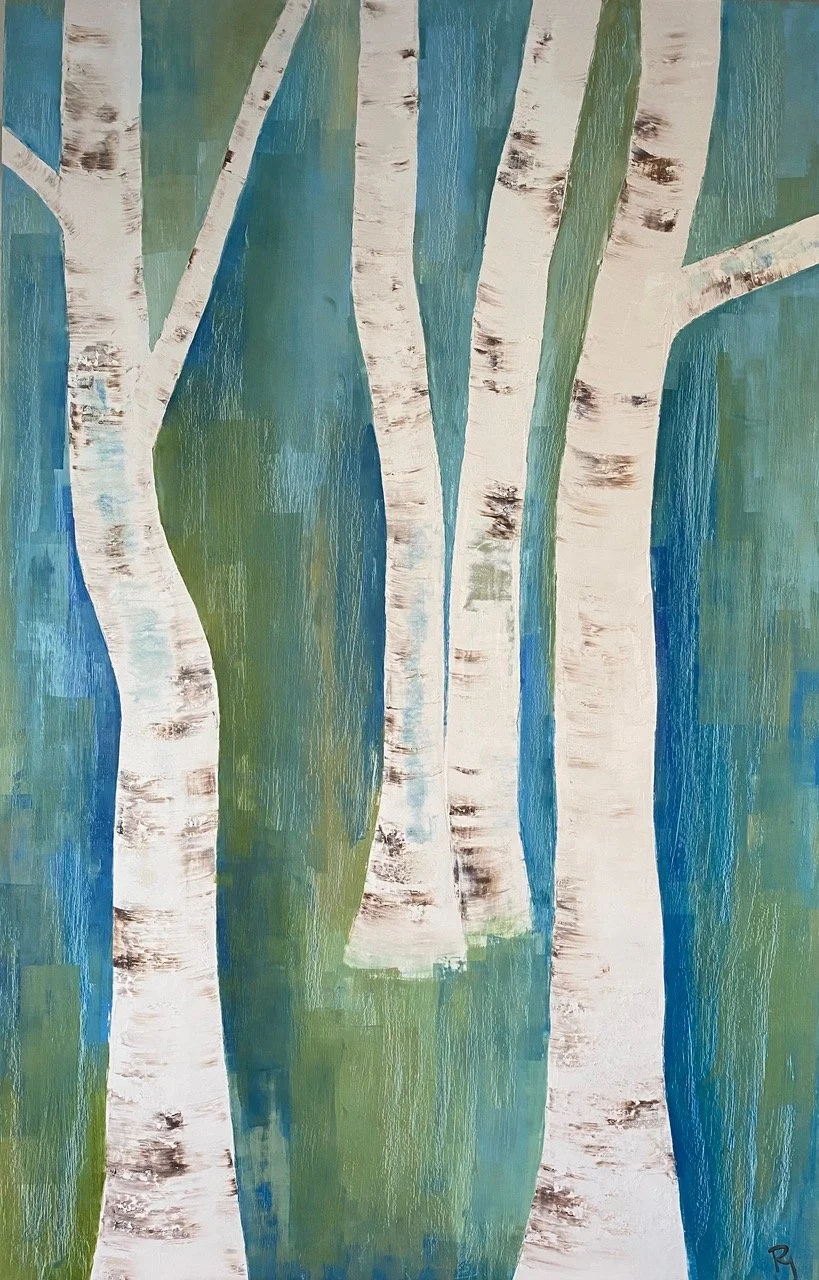Interview with Rachel Jones
Words by Evie Brett and Rachel Jones
As one of the exhibiting artists for Perceiving Nature, Rachel Jones kindly agreed to respond to some questions I had for her. In the following interview, Jones explores the ways which nature and its essence has informed her work, in both the showcased “Living Silver” and “Nature’s Quilt”, as well as her wider creative practice. Here, we discuss artistic processes, the wonders of the Yorkshire countryside and the importance of capturing and preserving nature’s beauty within art.
Rachel Jones linoprinting in her York studio.
“Nature’s Quilt”, linoprint, photography and collage.
Q: To begin, please tell me a little about yourself, your work and artistic practice and what inspires you creatively.
A: I live in York and work from my attic studio with a beautiful view across the rooftops of York. I paint, often using a mixed media of collage or mono print with oils, and I create linocuts that I handprint onto recycled cards, handmade papers and natural fabrics. I am constantly inspired by the plants and wildlife that surround and enrich my everyday life. I love my allotment and I love walking and obviously the feeling of reaching a mountaintop is thrilling but it is mainly in the little details that I find the most joy and wonder.
Q: How long have you been creating artwork and how has your style evolved over time?
A: My background is in textiles. I have worked for a wedding dress designer and managed a fairtrade crafts shop and had my own business designing and importing amazing, fairtrade, handmade wrapping papers. I then worked for many years at Brunswick Organic Nursery in Bishopthorpe leading craft groups enabling skilled workers with learning difficulties to make quality crafts. I have for years wished to do more of my own art and after attending Seek Art School classes for four years building techniques and confidence I found myself a studio a year ago. It has been a wonderful year of exploration and being absorbed in creating. My linoprints started as an idea for a card range and I hadn’t realised how compelling the process is! This coming year I intend to develop my painting and am excited about getting what’s inside my head out onto the paper!
“Living Silver”, oil paint, cold wax and collage on board.
Q: Please walk me through your creative process, how do you create your pieces?
A: For my linoprints I will often work directly from the natural object, such as a leaf, but also use colour plates in vintage books and photos to sketch my design. I guess it feels like a mark of respect to notice the detail, to wonder, to respond and to create art. For example, I first truly noticed the painted lady butterfly whilst walking the Cleveland Way with friends, our challenge somewhat overshadowed by the delicate butterflies who had arrived at our coast after migrating across the ocean at the altitude of aeroplanes. My linoprints are a grateful response to this wonder. After carving into traditional lino made from wood flour and linseed oil I handprint using vegetable oil based inks onto recycled or handmade papers. The sustainability of my materials is very important to me. In my painting of silver birches “Living Silver” I started with a base of tissue paper collage adding depth and texture to the tree trunks. The white bark of the tree sheds layers like gossamer tissue paper as it grows. I wanted to tell this part of the tree’s story in my piece.
Drawing the design onto lino (top right), the carved lino ready for printing (top left), printing the design onto handmade paper (bottom right), Acorn linoprint (bottom left).
Q: The Norman Rea Gallery gives students the opportunity to see a collection of artworks free of charge at every exhibition. How important is accessibility to you when it comes to your own artistic practice? What made you keen to exhibit at the Norman Rea Gallery?
A: As a new, full time artist I am delighted to be exhibiting at the Norman Rea Gallery. Art, like nature, nourishes, comforts and challenges us and is vital to our growth and health. Art and nature should be accessible to all.
Q: In what ways do you feel that nature is in connection to art? Are art and nature two distinct forces or do you think the line can be blurred at times?
A: Nature is the driving force and inspiration for my art. I believe it is in my nature to create. I definitely see a blurred line between the creation of nature and the creation of art. Both organically evolving.
Q: In what ways has the Yorkshire landscape and surrounding nature informed your work?
A: Living in York I feel so lucky to be surrounded by easily accessible, beautiful countryside. Walking in the Dales, Moors or Wolds is always restoring. As is my commute to and from my studio through Rowntree Park and along the river. We don’t need to travel far to appreciate the beauty on our doorstep.
Grass Flower - monoprint with oil paint.
Q: Do you think that there is a link between the way being out in nature makes you feel and the feelings you experience when creating and looking at art?
A: I have already used the words restore, nourish and enrich. They encapsulate the feeling of immersion I feel when I become absorbed in my art and time disappears and also describe how I feel outside being a part of nature.
Q: Perceiving Nature aims to capture the natural world in new and unexpected ways. In what ways do you feel that your work aligns with this idea?
A: I think we all need a prompt sometimes to notice what is in front of us. Art can make us see things afresh and in a different light. Certainly I try to pour the wonder I feel for what I’m drawing into my pieces and I hope this comes over.
Q: Finally, what does 'perceiving nature' mean to you?
A: I think to really look, to really notice and to feel gratitude and wonder and respond.





